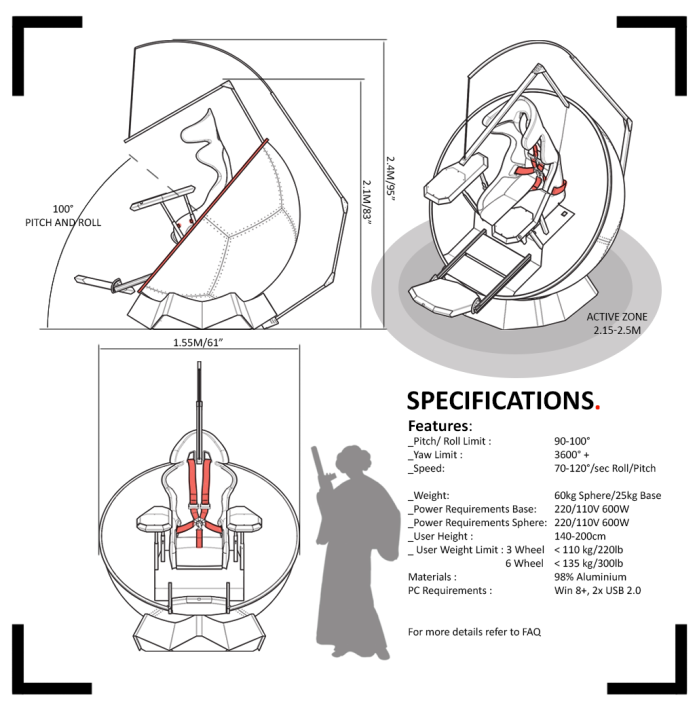This project has raised $240,000 on Kickstarter and $79,819 on IndieGoGo.
Feel Three is the Motion Simulator for Virtual Reality that puts you in the center of the action. Now is your chance to race Monte Carlo, try your odds in an asteroid field or fly a Spitfire literally by the seat of your pants. We have an incredible 90+ degrees of roll so you’ll feel every hairpin turn like you’re there and enough pitch pushing you back to make you think you’re on a Falcon 9.
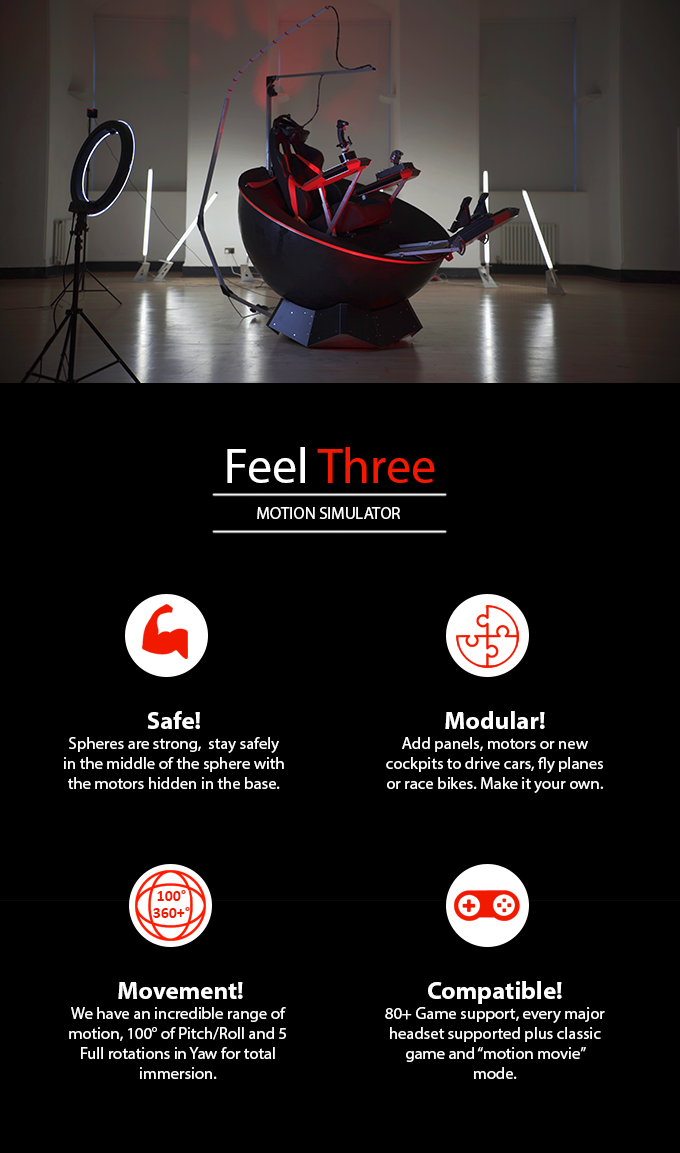

Virtual reality means that players are now able to experience racing and flying games with an amazing amount of realism, but while their eyes are telling them they’re zooming through a rocky valley, their body doesn’t move. By adding full body physical feedback, players can feel the thrill of moving at high speed with none of the danger. Motion simulators are traditionally beyond the budget of most gamers since they use hugely expensive linear actuators that only have a limited range of travel, but the Feel Threes motors quickly rotate the user instead. By pitching the sim backwards and forwards in concert to the game you feel acceleration and deceleration as the weight of your body is pushed backwards into the seat and released, while turns are felt with large rolls to the side.
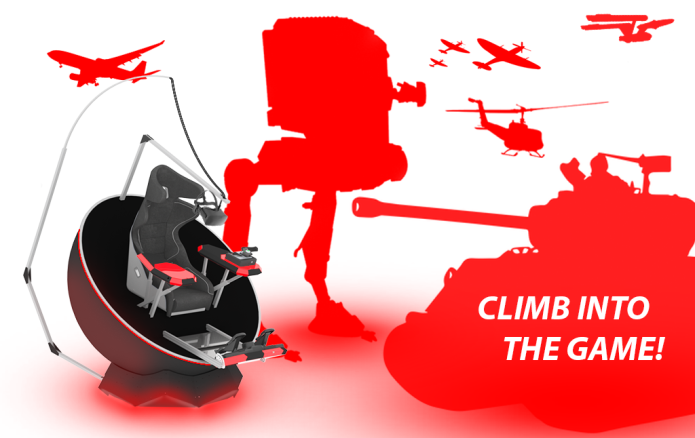
Most other sims have a small range of motion, so they try to intensify the experience by translating every tiny movement you might feel. They can’t generate g-forces for acceleration and turning, but instead simulate every minor bump in the road. This might be fun for a while, but they’re really just shaking your head around. Instead we put the bumps through our tactile transducers and leave the g-forces to our incredible 100 degrees of pitch and roll. You get all the fun of the track and none of the neck ache.


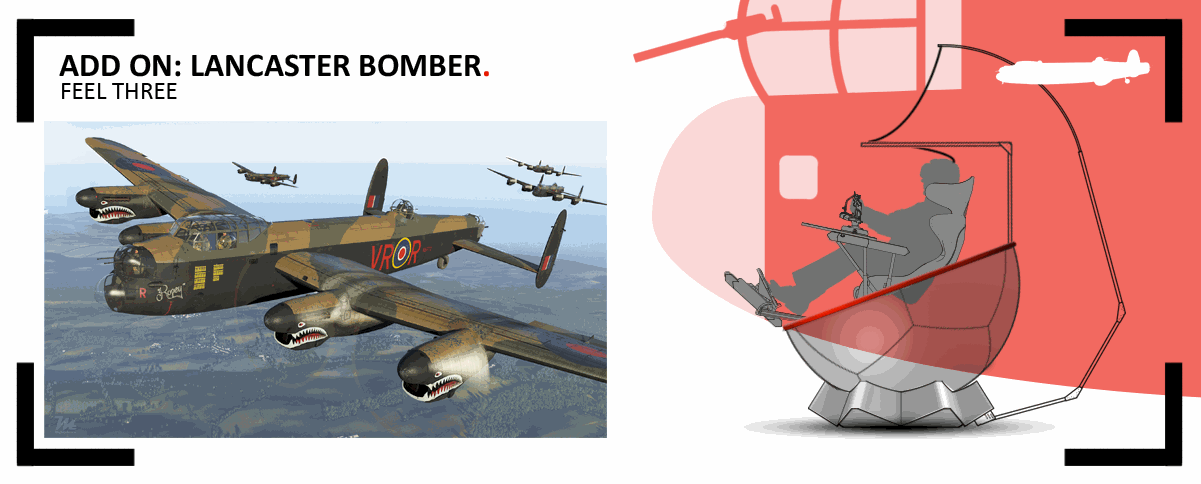


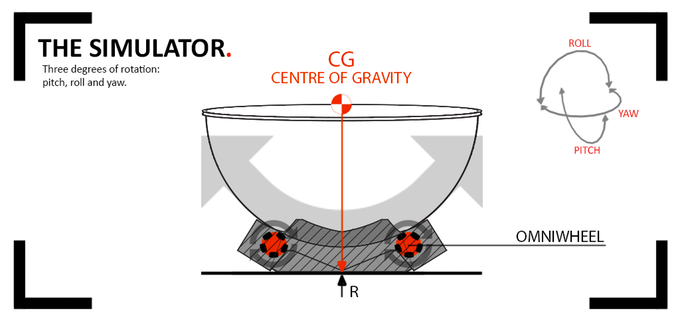
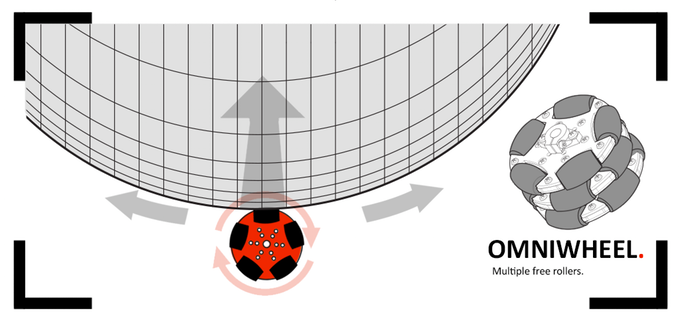
The simulator is a half sphere which sits in a base containing wheels and motors to move the user in three degrees of rotation: pitch, roll and yaw. Because the center of gravity is at the center of the sphere there is no lifting, and the simulator is very easy to move. The wheels in the base are omniwheels, which have multiple rollers, so they can add force in one direction while not interfering with the other motors.
Tactile transducers add vibration from the game in several places to increase immersion. These small, powerful devices let you feel your engine revs, gunfire and other impacts and are placed by your feet, hands and back.

A tracker near the players head constantly updates the orientation of the sphere and cancels the movement of the simulator from the players view. The simulator can accommodate users from children to tall adults, we support every type of controller and they can be quickly changed.
Each armrest has an easily removable plate of 220 x 280mm which users can attach their controllers to and these can quickly be swapped between play sessions. This is large enough to fit virtually every common controller type available. The most popular controllers chosen by backers will have holes pre-drilled and we’ll supply a chart for most other controllers so you can add your own holes. Steering wheels and flight yokes can be attached to a lightweight optional shelf which is attached to both armrests and can be rotated forward to let the user enter the cockpit. We will predrill holes for one of the 10 most preferred controller type or supply information on hole placement for many other wheels/yokes.
Full dimensions/drawings for these plates will be supplied to customers if they prefer to make their own or order them from local suppliers under a non commercial license. So you can make and order them, but not sell them yourself. We will also sell them if you want some spare.

We use our own proprietary software suite to control the simulator and calculate the optimal rotation of the 3+ motors to move the simulator and user. Users can control the speed and intensity of each game, as well as set limits on how much rotation they want to experience. Non VR titles are also supported by the use of a virtual 2D screen in front of the user, which is a great way to play much older games. We also use another program to pipe surround sound audio to the vibrating tactile transducers around the player, so they feel the game even when stationary. Finally we use an onboard tracker to measure the position of the simulator but also remove any simulator motion from the users view.

Every single game ever made is supported via Virtual Screen mode and controller mode input, even emulated and classic games. Use the software to define when your controllers do and enjoy thousands of non-VR games in a virtual environment. Set your joystick or wheel to rotate the sphere depending on your inputs and share your settings. This isn’t perfect since the simulator should ideally be taking cues from the in game vehicle physics, but it’s the easiest way to play classics like X-wing vs Tie fighter or Ace Combat via emulator.
We need to track the platform and uses these readings to cancel the movement in your headset. Many motion simulators have a small range of pitch and roll so the user can simply keep looking forward despite the movement and chance of discomfort. This then means their view will float around in the car as they drive, which is fine for some people, not ok for others.
Since we have such as massive range of possible motion, including the ability to completely rotate in the yaw axis, motion cancellation is a hard requirement.
There are currently six ways to achieve this:
Individual game support. Developers add code to read a VR tracker or controller and use this to cancel the motion.
Native Engine support. Unity or Unreal add this as a feature and developers simply enable the option and recompile.
An API wrapper. We use a small program that reads the rotation/position from a controller and the headset and cancels the motion for any game through the headset API. This can break on updates to the software that controls the headset.
Native support through the OpenXR initiative. This is a consortium of the major players in the VR industry with the aim of unifying VR hardware and software to a standard.
Native support from the headset manufacturer. The vendor adds, and updates their software to allow motion cancellation as an option so that it works for any title (or only certain titles).
This is the section where we might lose some backers, but we’re ok with that since we prefer to be transparent and honest. Other campaigns might avoid the pointing out the problem or say that there are no issues, but we think if you trust us with your hard earned money you deserve the truth. There is currently no acceptable motion cancellation for the Oculus rift. On OpenVR headsets such as the HTC Vive we have 100% functionality, but the rift currently doesn’t have a solution.
This is not to say there will never be a solution, and you can bet we’ll be working on the issue as one of our top priorities if we’re funded since rift users make up a huge portion of our possible customers. If you’re a coder who can solve this, we’d love to pay you to do so. We will be returning for the fourth time to Oculus Connect this year to again speak to Oculus about adding native support, so your pledges could make all the difference. Tell Oculus you want this as a feature and hopefully now they will listen, VR is amazing for simulation games, why wouldn’t they want to add support for all motion simulators?
If they don’t then we have the other four options above to use in pursuit of a solution, and the other sixth and final option for our backers. Switch to a SteamVR headset. We love the rift but if you can’t use it with a motion simulator then other HMDs are not too different in price or features.















If you intend to charge someone to use your Feel Three simulator, by the hour, week or event, you need a commercial licence & insurance. This is currently $2000. For more information, please see the FAQ or send a message.
If we don’t make it, we don’t want to sell it to you. We’ve already set ourselves up the pretty monumental task of manufacturing and distributing the simulators and battle stations, we would rather leave the other stuff to Amazon and Best Buy instead of marking up prices to pay for the inevitable support and overseas shipping.
Bucket Seats : There are a thousand options and a thousand opinions about chairs. We’d rather you picked something right for you, after all, you’ll be spend all your free time in a sim now, you better get it right. We’ll even give you some recommendations and advise what is the best fit.
Controllers : Like seats the interface with your vehicle is personal and very important. We’ll support the most popular wheels and joysticks, and provide advice on attaching any controller to your sim, but we’ll only sell spare adapter plates, not the peripherals.
LED strips : The holes will be there for you to do as you will. LED strips are cheap and pretty easy to install, so we’ll provide some tutorials but not the hardware.
Colour : The Simulator and Battle Station come as bare metal. This makes it more affordable and gives you the option of then picking your own colour scheme instead of painting over something you didn’t want. Spraying and vinyl wraps are good options, we look forward to seeing the crazy designs. The lycra sphere cover comes in black.

Stretch goals are a great way for many crowdfunding campaigns to sustain interest through its life, but only if they are sensible and properly planned. Over ambitious goals might make a project seem more appealing but fulfilling these extra rewards can easily affect the core of the campaign and delay, or sometimes even kill, the project. We’re now in the business of manufacturing a kick ass motion simulator, which we’ve already heavily prototyped and is working really well. Adding extra shiny features because every campaign seems to do this is not how we want to move forward. Trust us, any suggest you might have has already probably been considered, and if it was too hard or expensive it didn’t make it in to the project. This is not to say the design won’t change moving forward, but we would rather add something as a nice addition you didn’t expect, rather than add something you didn’t really want, and make you wait another year.
Our business is building amazing sims! No T-shirts, no souvenirs, and no crazy stretch goals!

Instead of Stretch goals we have a list of Visions of how we would like to move the company forward. The sphere is pretty big and a reclined bucket seat configuration is just the beginning of what’s possible. We’ll have options to switch out Battle Stations for a load of other cool options.
Central Joystick mount : We have the prototype. It’s an easy addition to move your stick to between your knees. Chopper pilots, relax, it’s coming.
Monitor Mount : We LOVE VR here at FeelThree but we know not everyone else does, so we’ve already prototyped a simple monitor mount that clips to the wheel shelf, to will be announced when it’s ready. This will be for small lightweight wide screen monitors, not 50” monsters since a major consideration is the change in the center of gravity, and the extra stress on the mount and monitor.
Fan. We can get the speed you’re moving from the game so a powerful fan linked to your forward motion really adds another dimension. We prototyped it, it’s awesome.
Virtual hotas : We love real buttons, HAT switches and dials, but you’re in VR, which makes it a little tricky to hold a joystick and also push virtual buttons with a VR hand controller. So we want to make a simple mount you can magnetically attach to your controllers to make a nice in game joystick. Perfect for touch or Valve Knuckles while playing awesome games like VTOL VR!
Projector mount/screen : If a monitor isn’t big enough then how about a lightweight wrap around screen fed by a couple of pico projectors?
Heave : Everyone wants to go up and down, and so do we. A heave add on will likely be our first major upgrade to the simulator. There is a lot of space beneath the battlestation to add it, but lots of work still to be done since it changes the center of gravity. We’re pretty sure it can be done though, watch this space!
Speeder bikes : Although we know there are plenty of people who love motorbikes (so do we!) we can do that in real life. Boring. What we can’t do is blast through the forests of Endor, shooting up stormtroopers and dodging Ewoks. With a couple of massive fans on the front and a counterweight below (so you can’t fall off) you’ll be saving the rebellion in style.
Cushions : The simulator with no chair or cables, just the lycra cover, looks like a work of art, but is not too comfortable to climb into. So we’re planning on some beautiful triangular cushions that magnetically attach to the inside of the sim. Instead of racing cars you can be meditating or chasing dreams as you gently rock to sleep.
Paragliding : Our founder is a paraglider, and although he loves it, admits it’s not the safest sport. With a simple frame and a couple of fans you could hang in a simulator instead and never worry about power lines again!
Full 360° : This is a major challenge, but one we’re really interested in. We’d like to do it, not sure if we should, but something we’ll be investigating more as time goes on.
Smaller Spheres : We have a great, and really simple design for a smaller version that we will continue with more funding.
Got a suggestion? We love to hear your ideas, maybe we’ll add it to the list!


When we reach £500,000 in total company funding we will be joining the OpenXR group in order to represent motion simulation hardware in VR, and we hope this campaign will help us get there sooner. This is an important initiative from many of the top players in Virtual Reality to move towards a real standard so everything ‘just works’, especially native motion cancellation.

Shipping is complicated for most projects, but this goes double for a motion simulator. However, we think we’ve come up with a fair way to cover shipping worldwide that keeps things extremely simple.
For most people shipping is included in the price, that is, we will cover the cost of the most economical shipping up to $200 from a main distribution point. So if you live in North America or Western Europe you need only wait patiently since we anticipate no extra charges. If you order from a country that doesn’t justify at least a half container your product will be shipped from the next best distributor (or direct from the Manufacturer) and you will be required to pay the extra shipping, which will be at cost. We won’t offer shipping upgrades but will of course provide tracking.
One of the reasons we’re able to offer our simulator at such an amazing price is partly due to the fact that it comes semi-built, so some assembly is required. All required tools will be supplied as well as a manual and videos demonstrating the build procedure. If you’re not so handy we would recommend considering Task Rabbit or similar to do most of the building. It should only take an afternoon or so.
Backers will be required to pay all import taxes and duties before final delivery. Since we’re based in Europe we’re required to pay the VAT when we receive the funds, so backers who pay tax will need to reimburse this before we ship.

